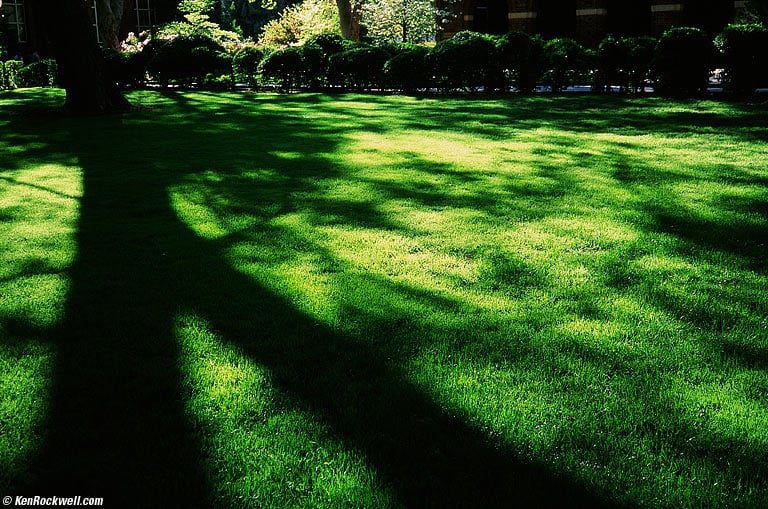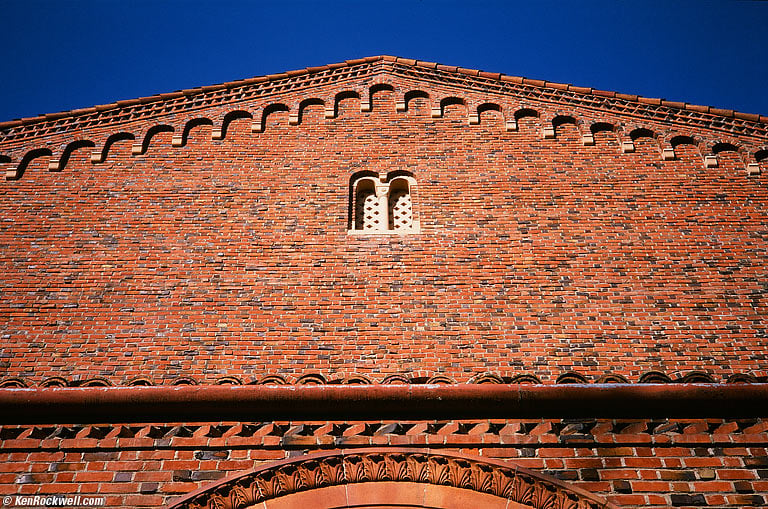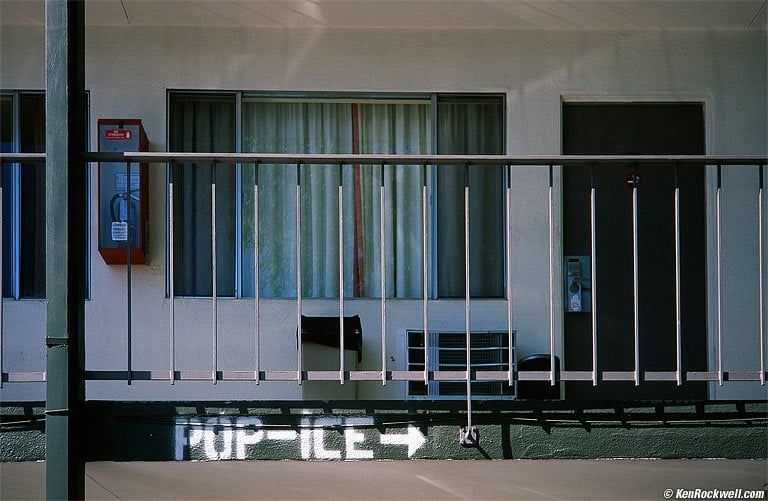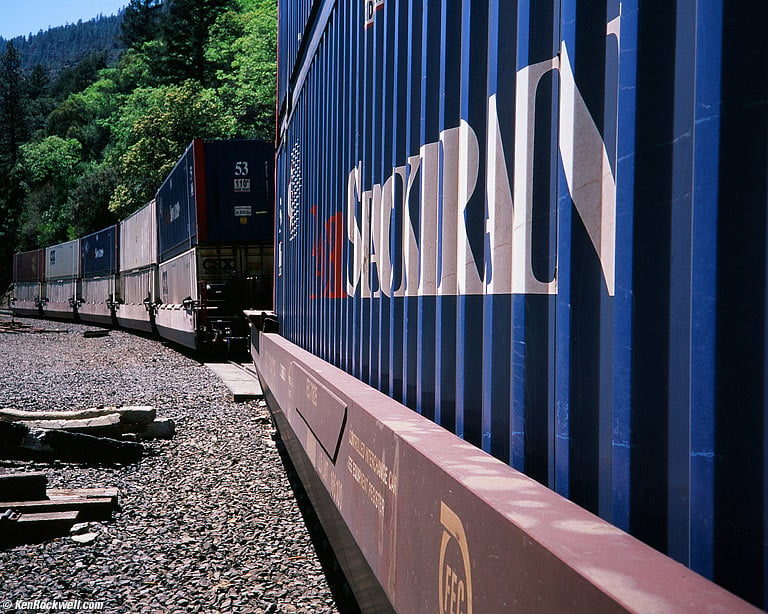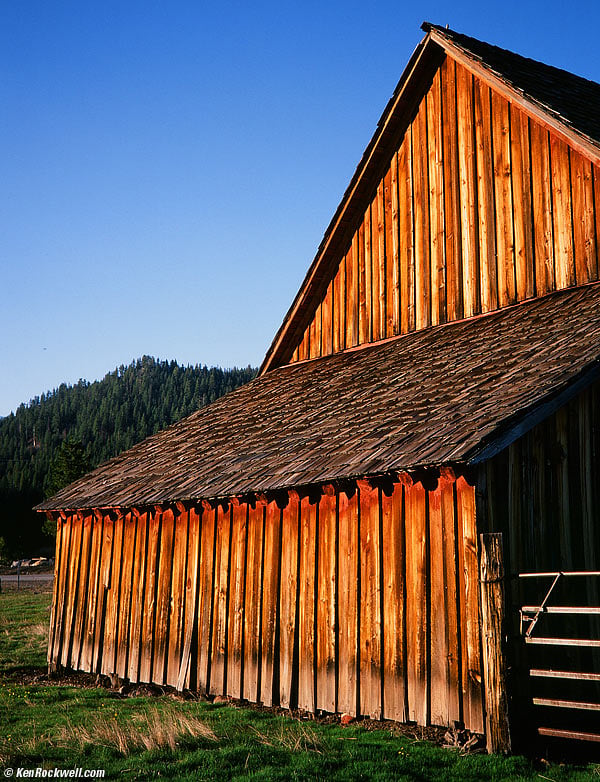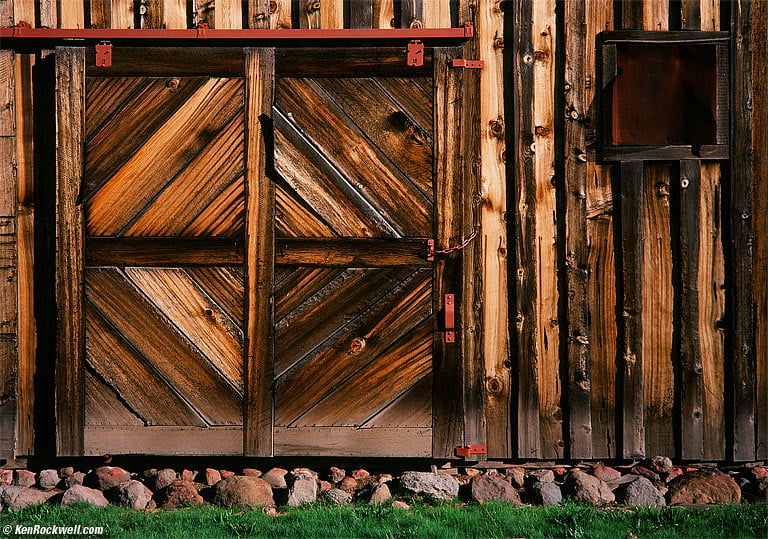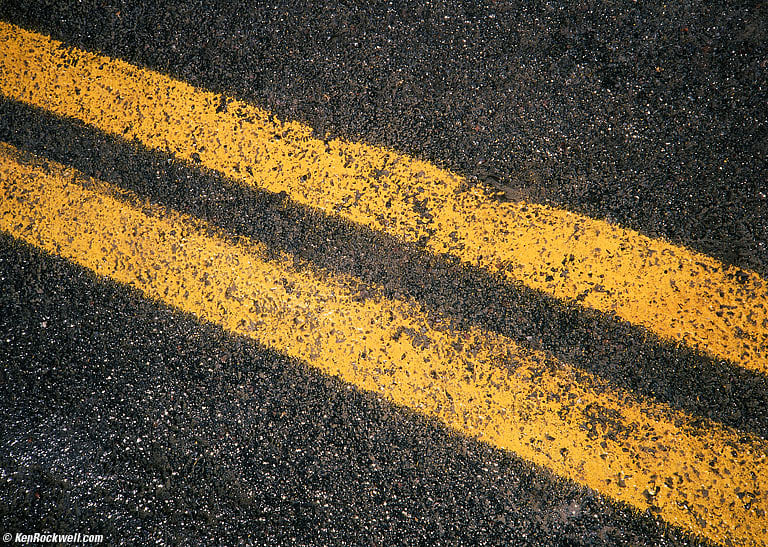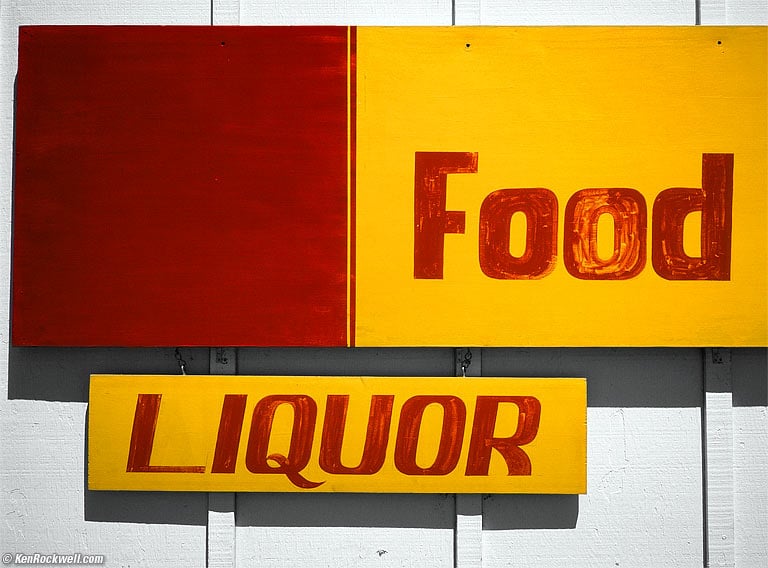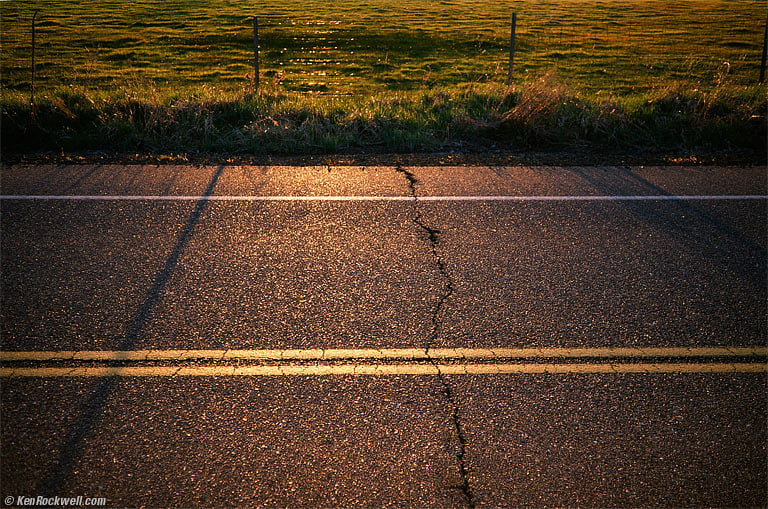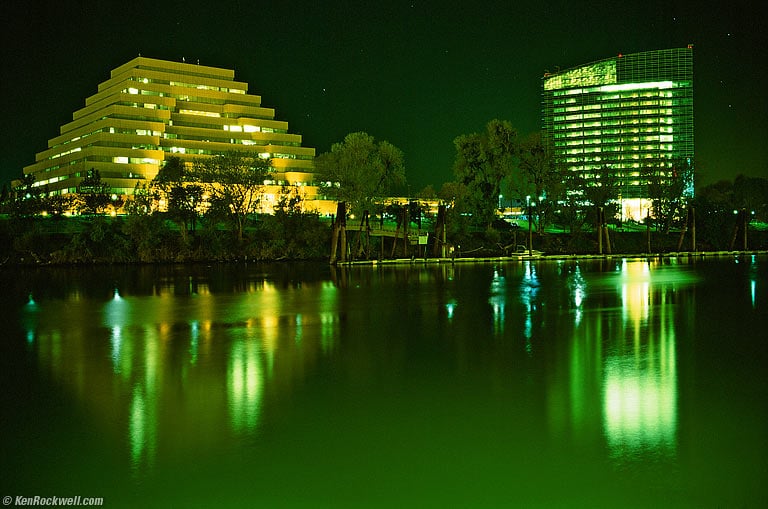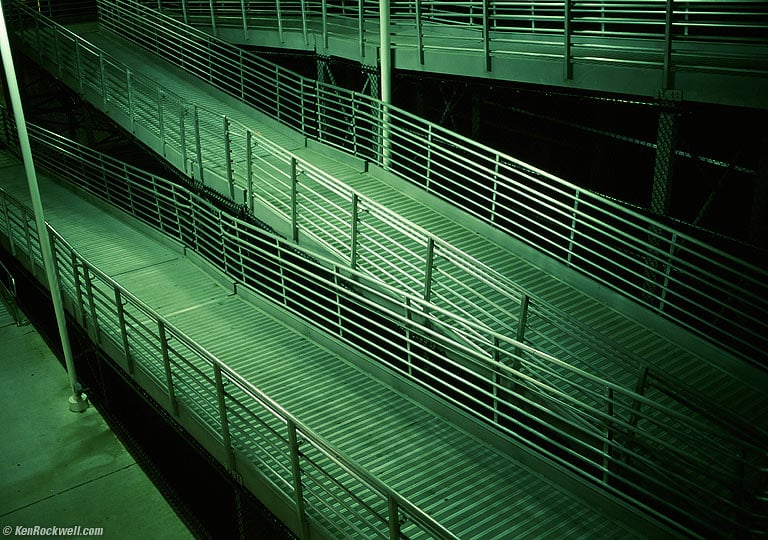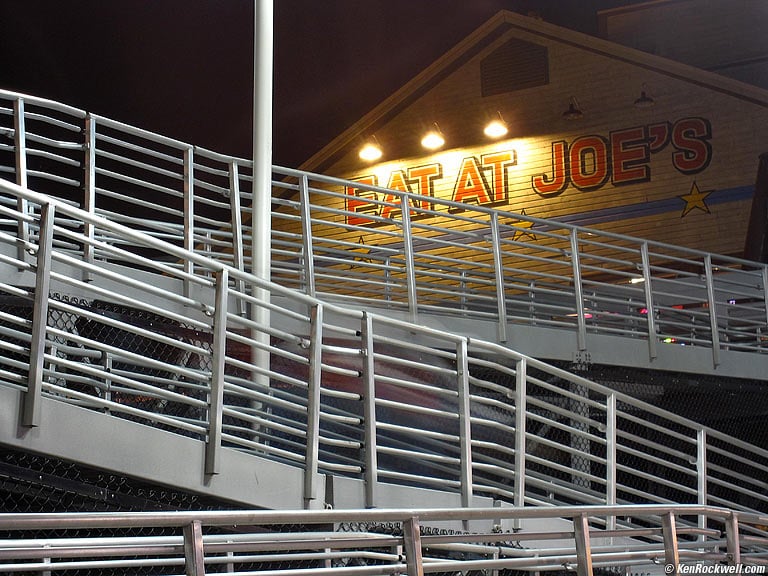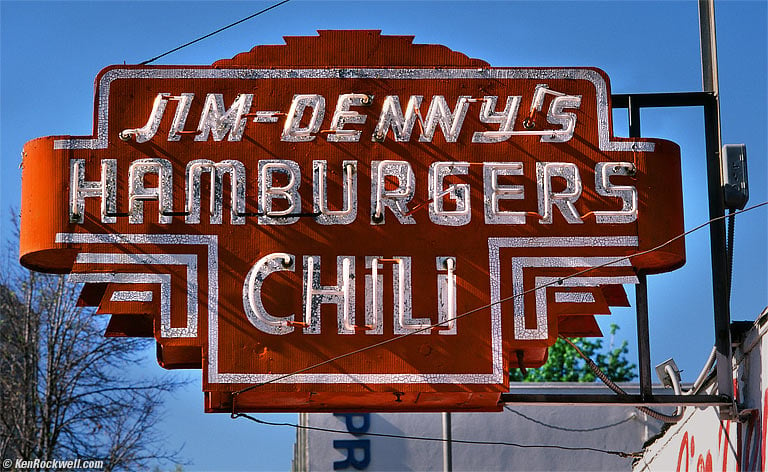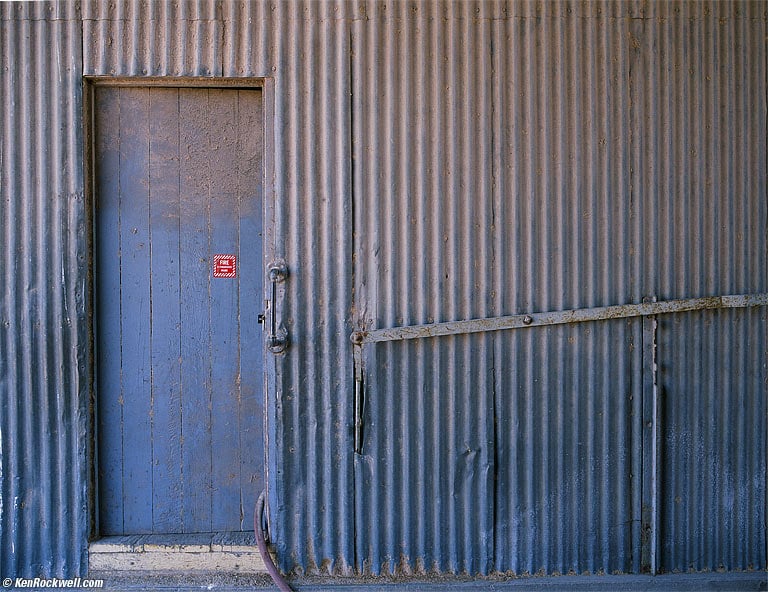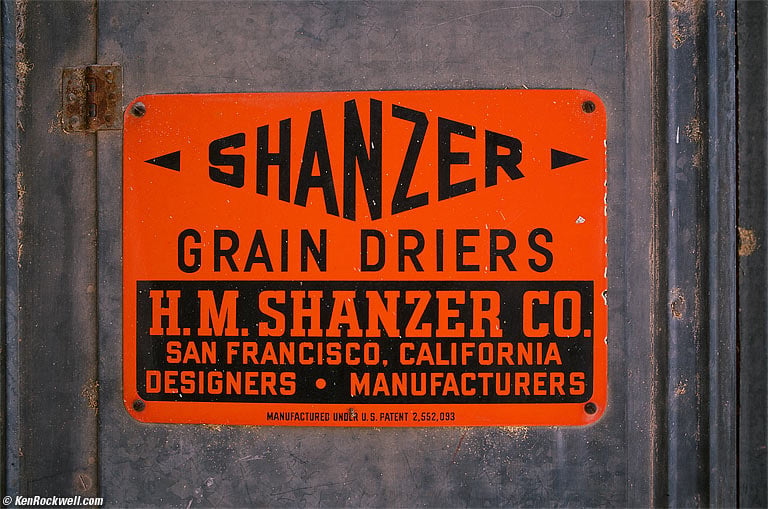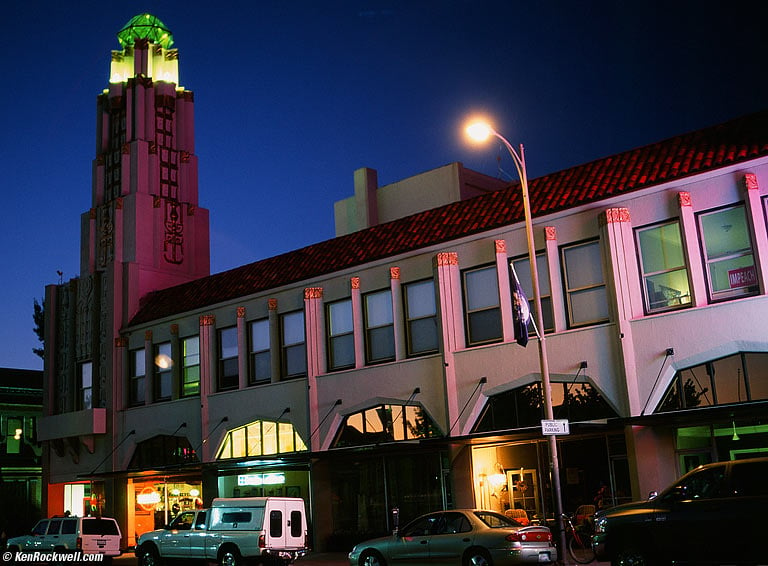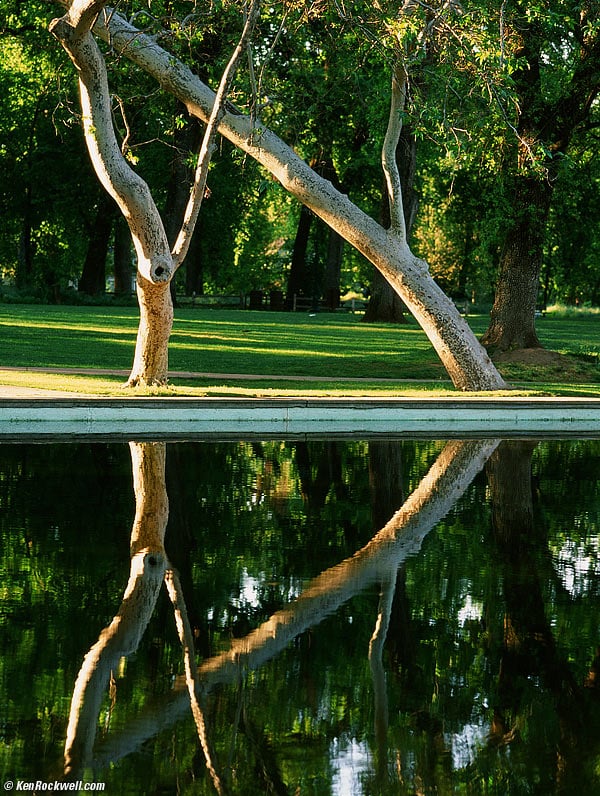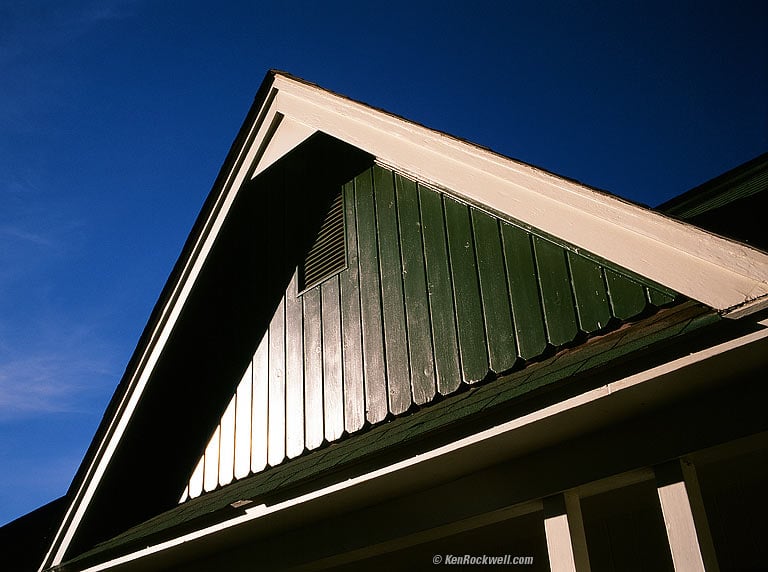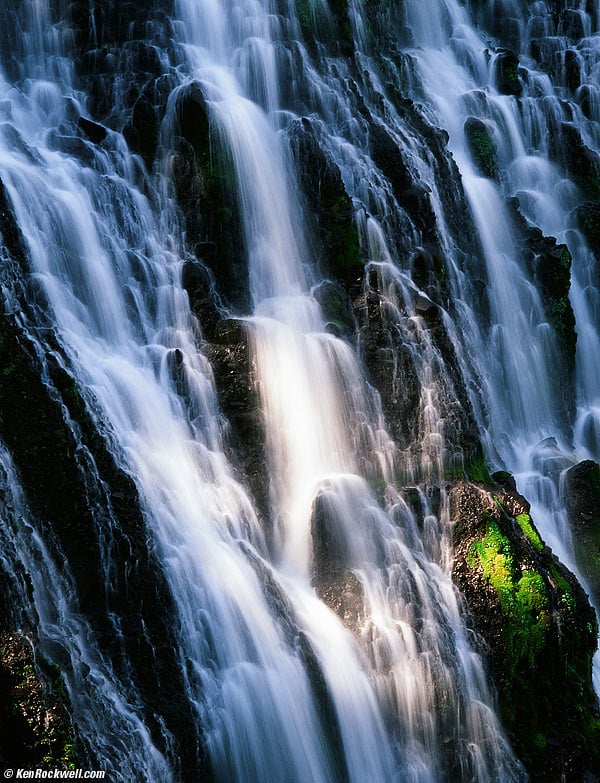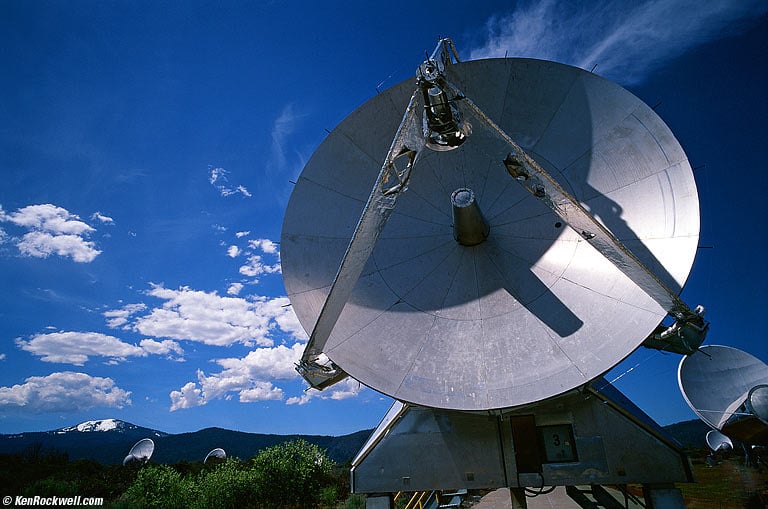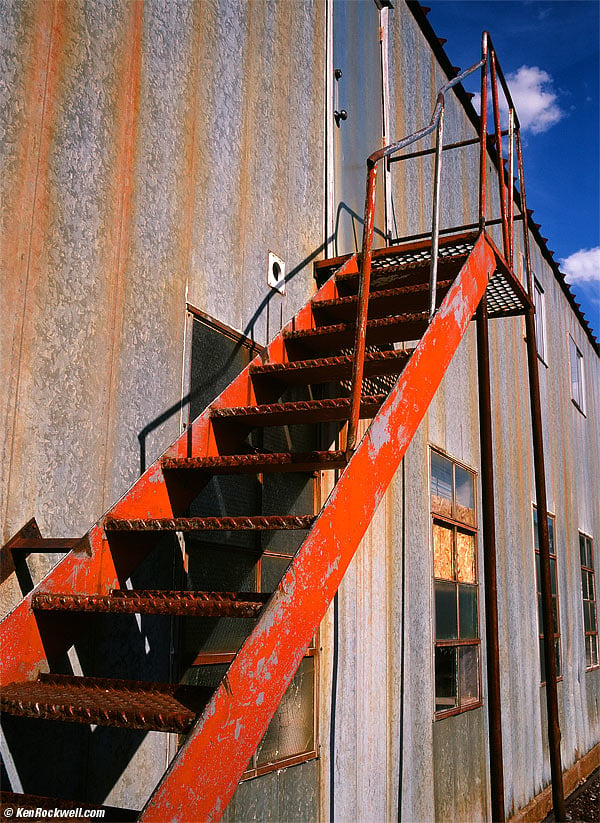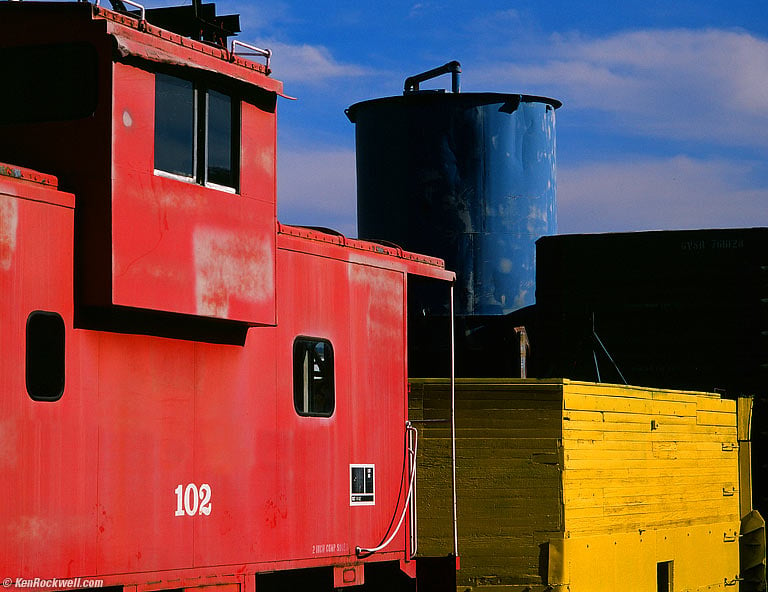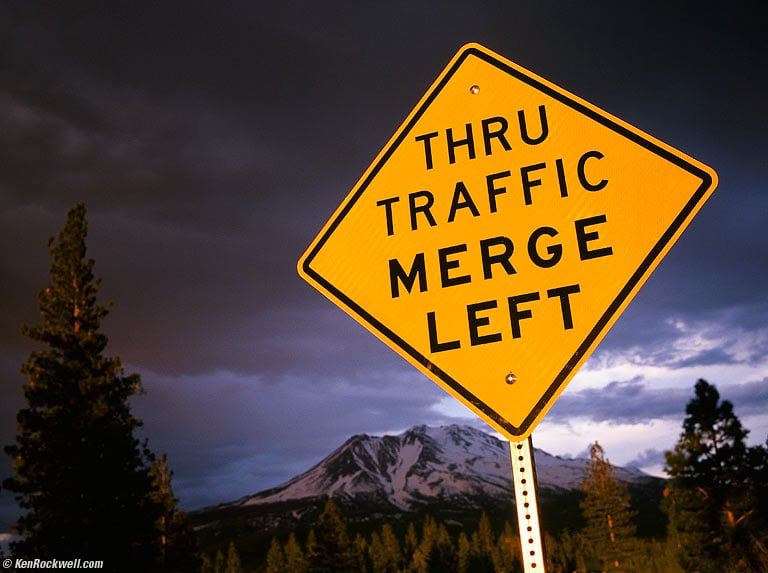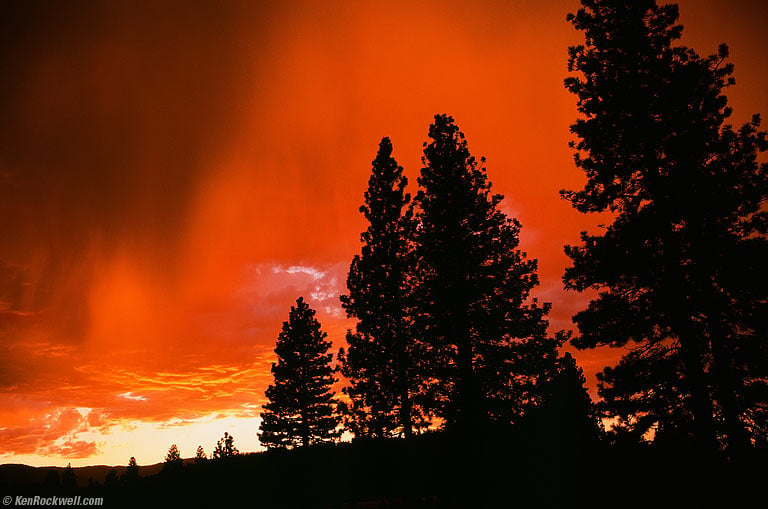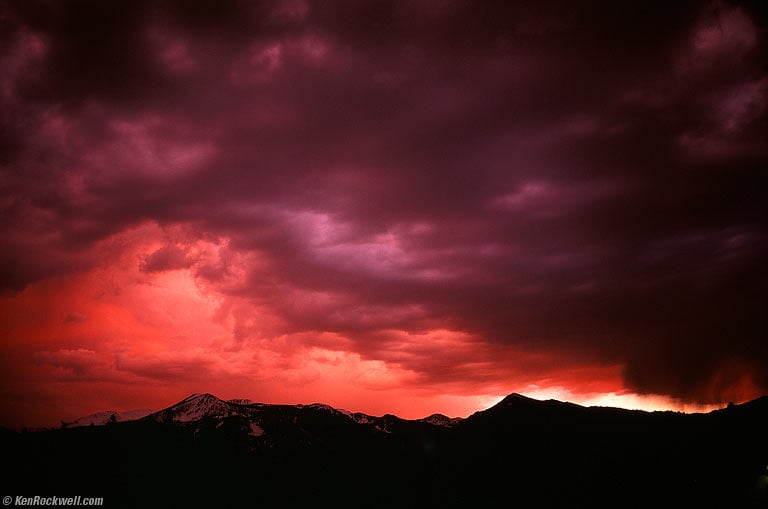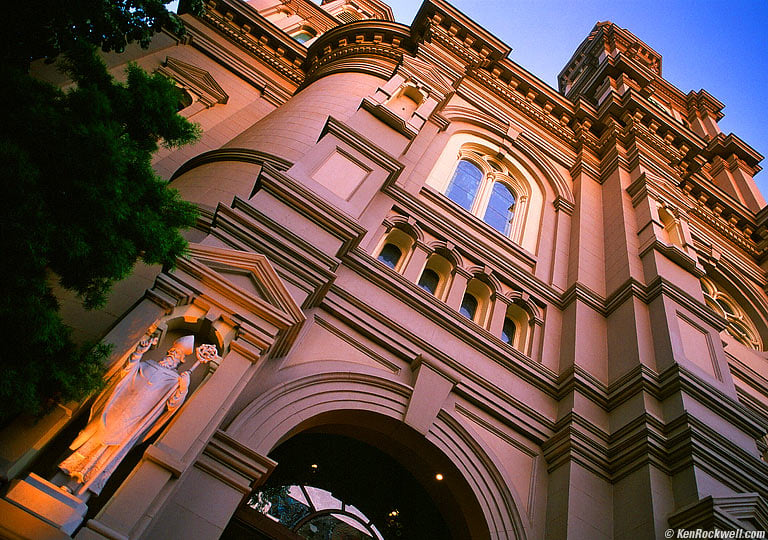Home Donate New Search Gallery How-To Books Links Workshops About Contact
Volcano Country
Northern California, April
2009
© 2009 KenRockwell.com. All rights reserved.
I went on one of Dave Wyman's excellent photo tours that ran from Friday, 17 April 2009 through Wednesday, 22 April 2009. Dave posted his own page of his photos, and here is Dave's trip description.
Here are some of the snaps. I explain what cameras I used and why at the end.
Here we go!
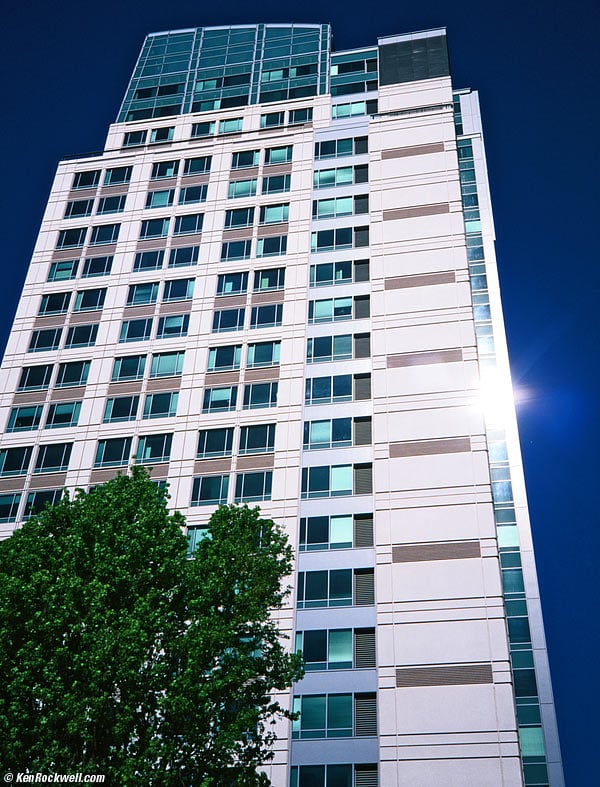
California EPA, Sacramento, California. Saturday Morning, 18 April 2009.
I made this snap from the parking lot of the Best Western as we loaded up on Saturday morning, 18 April 2009, to head out on our first full day of shooting.
I moved around until I had the sun reflecting right at me. I pointed my camera to the side, pressed the shutter halfway to lock the exposure, recomposed while trying not to be blinded by the light, and shot.
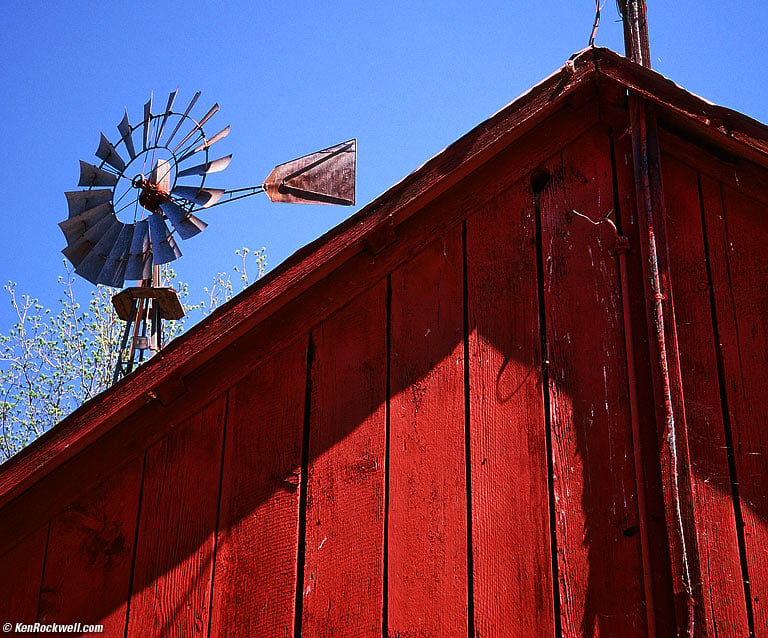
Ernie's Farm, Willows, California. 2:30 PM, Saturday, 18 April 2009.
Green Light, CSU Chico, Chico, California. 5 PM, Saturday, 18 April 2009. enlarge.
Grass looks greenest when the sun is shining through the grass. I'm standing in the tree's shadow so I don't see the disc of the sun, but the grass is set aglow by the backlight.
If I had shot from the usual direction it would have looked like regular grass, but shooting into the sun, it glows green.
Orange and Blue, CSU Chico, Chico, California. 5 PM, Saturday, 18 April 2009. enlarge.
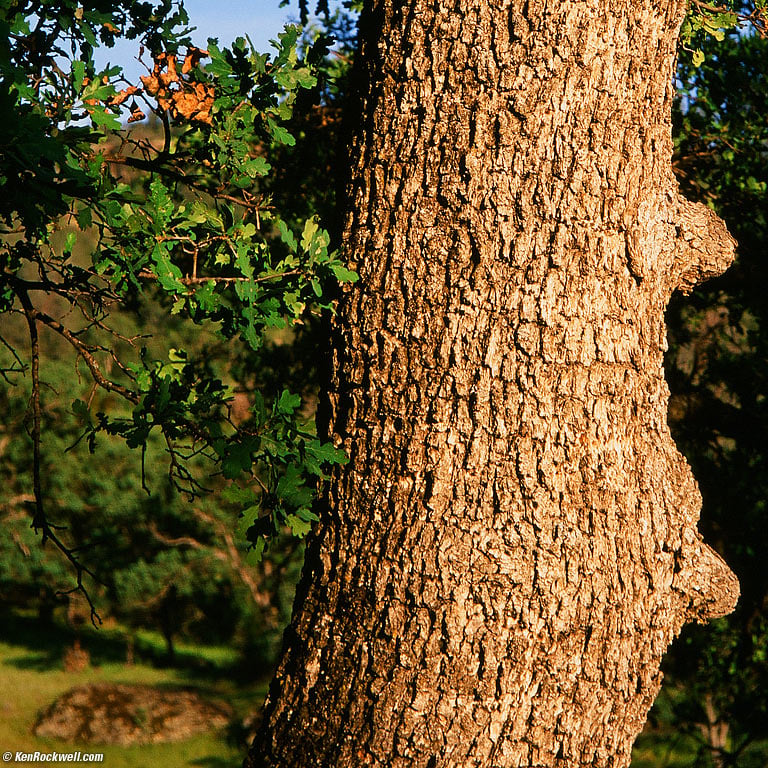
California Oak, Bear Hole, Big Chico Creek, Upper Bidwell Park, Chico, California.
6:30 PM, Saturday, 18 April 2009.
I cropped this shot into a square.
POP-ICE, Vagabond Inn, Chico, California. Sunday Morning, 19 April 2009. enlarge.
I shot this looking up. Since I didn't bother bringing my 4x5," the lines skewed-in towards the top. I straightened them out later in Photoshop's Lens Distortion Tool.
I deliberately let most of the photo remain dark. The thing you're supposed to see first is "POP-ICE ->," which is why it is the brightest part of the photo. 99% of the image area is the dim, seedy motel, which sets the backdrop for the stenciled sign.
Pulga, California. 1:30 PM, Sunday, 19 April 2009. enlarge.
Pulga is Spanish for "flea."
Child's Meadow, California. 7 PM, Sunday, 19 April 2009. enlarge.
Child's Meadow, California. Monday Morning, 20 April 2009. enlarge.
Stripes, California. Monday Morning, 20 April 2009. enlarge.
Shell Station, Chester, California. Lunchtime, Monday, 20 April 2009. enlarge.
Sundown, Cassel Road, Hat Creek, California. Monday, 20 April 2009. enlarge.
All the shots above were made with the garage-sale Olympus 35RC, worth about $15. Most were made at 1/60, auto aperture and a KR1.5 skylight filter.
These shots look fine to me.
This shot of the road was made on frame number 38, a luxury that electronic-wind cameras, like the Nikon F6 and Contax G2, don't provide since they don't get 40 frames on every roll, as I do on the 35RC. Those cameras waste the first few frames so they only get 37 frames per roll.
Just for comparison, here's the above shot as made with the LEICA M7 and LEICA 21mm f2.8 ELMARIT-M ASPH, which instead of costing $15 like the Olympus, sells for about $8,700:
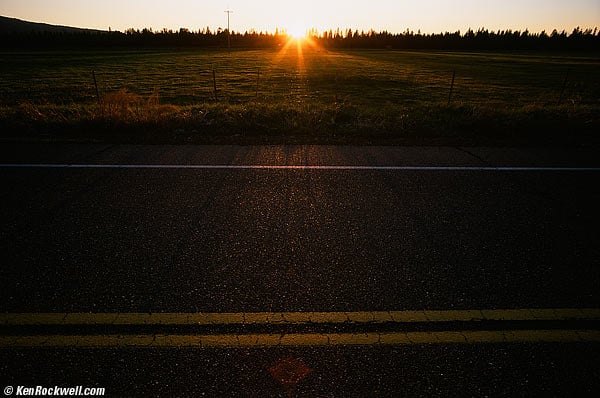
As shot with the LEICA M7 and 21mm f2.8 ELMARIT-M ASPH.
The Leica shot is dreadfully underexposed. The Leica's center-only meter should have nailed this, ignoring the sun, and even if it wouldn't, I locked the exposure on what I wanted anyway.
It's most likely way underexposed because my M7 has a flaky DX and ISO reading system which often reads incorrectly and underexposes a stop. In any case, my M7 is in Germany as I write this for repair, while the 35RC is busy making photos. The M7 was also making some frames that were completely black, and it wasn't because I left the lens cap on. To Leica's credit, they loaned me an M7 to use while mine is on holiday in the Fatherland, and I'm putting it to good use. Thanks Leica!
Buying the LEICA buys you a well-made camera. It does not buy you better pictures, and does not buy you better reliability.
That said, the rest of these snaps are made on the M7, taking advantage of what it can do that the 35RC can't, which is perform in lower light and use wide and tele lenses.
Sacramento River, Sacramento, California. 10 PM Friday, 17 April 2009. enlarge.
This was snapped with a Leica M7 on a tripod with a Leica 35mm f/1.4 SUMMILUX-M ASPH lens at f/2.4 for 27 seconds. I locked the auto exposure on something appropriate, and the M7 automatically clocked it off. A cool thing about the M7, unlike any other camera, is that the LED in the finder counts down in seconds as it makes the automatic exposure.
Mercury vapor lights, the ones that look blue-white to our eyes, look green to cameras. The dots in the sky are stars.
I've gotta love the Leica 35/1.4. It's super-sharp even wide-open, so I don't have to stop down to f/5.6 and wait around for 5 minutes for my Velvia to expose in the same conditions, considering reciprocity failure. The Nikon 35/1.4 doesn't come close, and the discontinued used Nikon 28/1.4 costs twice as much as a used Leica 35/1.4 ASPH. Either Nikon lens is twice the size, too.
Old Sacramento Public Dock, Sacramento, California. 10 PM Friday, 17 April 2009. enlarge.
This was snapped with a Leica M7 and Leica 35mm f/1.4 SUMMILUX-M ASPH lens at f/1.4 for 1/3 of a second on ISO 50 film. Like the shot above, the green cast comes from the way cameras respond to mercury light.
Even though I had a tripod with me, I didn't waste my time using it. Why bother? The non-SLR Leica is so smooth that I set the tripod down next to me, and hand-held the camera on a railing for a third-of-a-second exposure. You don't need a tripod because the Leica 35/1.4 is so sharp at f/1.4 that you don't need to stop down for a longer exposure to get a snappy image.
I did bother with my tripod with my Canon SD880 digital point-and-shoot. I set it manually to ISO 80 and made this shot from the bottom of that walkway on AUTO WB, which balanced perfectly to make the light look as it did to my eyes.
Joe's, Sacramento. 9:24PM, Friday, 17 April 2009. enlarge. Canon SD880 at 17.2mm, f/5.6 at 1/4, tripod.
Note how the Canon SD880 image starts looking digital in even my small (1,500 pixel) enlarged version. The colors are a lot better at night, but the finer image structures just aren't there, and I prefer Velvia colors in daylight. For me, it's all about color.
Burger Joint, Sacramento, California. Saturday Morning,18 April 2009. enlarge.
This was snapped with a Leica M7 and Leica APO-SUMMICRON-M 90mm f/2 ASPH lens with a 55mm Hoya HMC 81A filter.
The 81A filter is mild warming filter. I use it for most of my daylight shots to get the slightly warmer color balance I prefer. On digital, I get the same thing by setting my Nikon's Auto White Balance to A3.
Charon the Ferryman's House, Princeton, California. Saturday Morning,18 April 2009. enlarge.
This was snapped with a Leica M7 and Leica 35mm f/1.4 SUMMILUX-M ASPH lens at f/2.8 at 1/45, with a 46mm Hoya HMC 81A filter.
Here's another version:
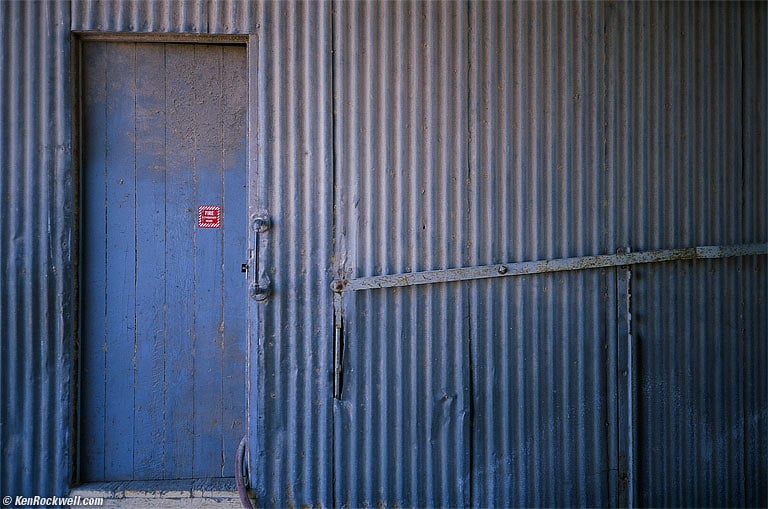
Charon the Ferryman's House, Princeton, California. Saturday Morning,18 April 2009.
Can you tell what changed? You shouldn't have to look very hard.
Isn't is obvious? Doesn't the superior sharpness, color fidelity, subtle gradation of tone and color, superior highlight and shadow detail, definition and delineation and the overall "glow" just scream that the first photo was made with an $8,600 Leica M7 and Leica 35mm f/1.4 SUMMILUX-M ASPH lens, while the second photo was made with a $15 Olympus 35RC and its clearly inferior 42mm f/2.8 E-Zuiko lens?
Leica Man, where is your aura of bokeh to save you? Where are your complicated technical explanations of why your camera is superior? Have you lost your words? Why cannot your superior camera make superior photos to my garage-sale cutie? Does not your camera make you a better man than I? (If you're not getting the humor, try imagining these words in the voice of Mike Myers playing Dr. Evil.)
Does ASPHERICAL describe your space ship? What does ASPHERICAL mean? Is it the shape of Salgado's head? (It turns out that Sebastião Salgado, one of the worlds greatest photographers of all time, who also shot Leica, upgraded in 2004 to the inexpensive Pentax 645 for its superior technical quality to allow him to hang larger prints, and then got tired of carrying it and now shoots a Canon Mk III, or so I'm told.)
I can't see any difference, and this is exactly why Leica men are superior to us. (Actually, the 35RC has superior bokeh to the Leica 35mm f/1.4 SUMMILUX-M ASPH, but it doesn't really matter for lenses this short .) The Leica man clearly sees all these things, and much more, between these two pictures. The only reason I brought a Leica on this trip is because it weighs so much less than a Nikon F6, or even the lenses for a lighter Nikon.
Actually there are some differences between these images, other than the sweet smell of an extra $8,585 in your pocket. The color balances are slightly different because I had a KR1.5 filter on the Olympus and an 81A on the Leica, since I have no 81A for the Olympus' screwy 43.5mm x 0.5mm filter thread.
The Olympus was shot at 1/30 and auto chose about f/3.1, so it's running wide-open, where it's the least sharp.
If I blow up both images to 48" (120cm) wide I can see some slight sharpness differences, and those are the minutiae about which I speak when I write reviews. These slight differences make no difference in actual shooting. The only reason I mention lens sharpness in reviews is because all you people ask, and it gives me something to write about. All lenses since about the 1930s have been sharp enough; get over it.
I am working on another page where I'll show these two cameras in my usual full smack-down exposée, but this page is a polite gallery, not the steel cage match I'm planning.
Ok, the rest of these are made with the Leica. I would have made the same snaps with an old Nikon EL and a few manual lenses; I would just have had to carry more weight.
Princeton, California. Saturday Morning,18 April 2009. enlarge.
This was snapped with a Leica M7 and Leica 35mm f/1.4 SUMMILUX-M ASPH lens at f/4 at 1/60, with a 46mm Hoya HMC 81A filter.
Chico, California. Saturday Evening,18 April 2009. enlarge.
I snapped this with a Leica M7 and Leica 35mm f/1.4 SUMMILUX-M ASPH lens as I ran to catch up with the group on our way to Woodstock's Pizza. I shot it at f/1.4 at one-third of a second, hand-held of course.
Dancing Trees, Lower Bidwell Park, Chico, California. Sunday Morning, 19 April 2009. enlarge.
This was snapped with a Leica M7 and Leica APO-SUMMICRON-M 90mm f/2 ASPH lens with a 55mm Hoya 85C filter. Exposure was something like f/2.8 at 1/45.
I used an orange 85C filter to do the same thing as choosing shade white balance, which gets the normal-looking photo above, instead of a nasty blue cast from the sky.
The photo would be a boring blue without the filter (or correct WB setting) because most of it was lit from the sky; not the direct light of the sun.
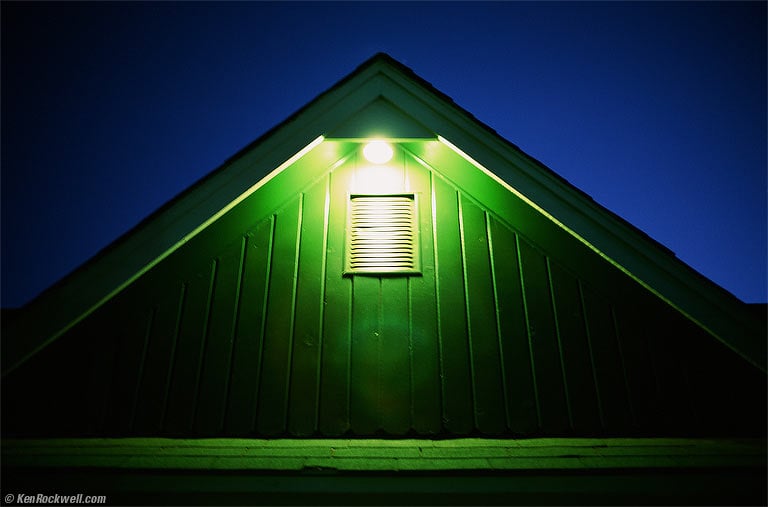
Green Triangle, Burney, California. Monday Evening, 20 April 2009.
Photographed with the Leica M7 and Leica 35mm f/1.4 SUMMILUX-M ASPH lens.
Exposure: f/1.4 at one second, hand-held, on Fuji Velvia 50 (ISO 50) film. The lens' light falloff helps add to this effect, emphasizing the center and keeping your eyes from wandering out of the frame.
Yes, I had a tripod someplace, but who needs a tripod for a short (only one-second) exposure? If I had bothered to walk 20 feet (6 meters) to find it, the fading blue light in the sky would have gotten darker, giving instead a black, instead of blue, background. That would have killed the shot and it was dinner time.
Light changes much more quickly than we realize after the sun has set; ideally I would have been paying attention and made the shot a few minutes earlier.
The bluish-white (mercury) light at the top helped me. It looked bright white as I was there, but I knew it would render as green in my photo (just like the shot above of the Sacramento River), emphasizing the green of the motel.
This isn't a photo of a green gable or of the Green Gables Motel. This is a bright green triangle surrounded by dark blue. Photos are never about the subject; they are always about their basic underlying compositional structure. In this case, it's a green highlight in a dark blue surround.
Sharpness? Who cares! If you have the basics down, so long as at least one thing is sharp, you've got a picture.
Green Gable, Burney, California. Tuesday Morning, 21 April 2009. enlarge.
Snapped the next morning with a Leica M7 and Leica 35mm f/1.4 SUMMILUX-M ASPH lens at f/11 and 1/90, with a 46mm Hoya HMC 81A filter.
Since the glare from the glossy paint was so blinding, I pointed the camera at something else, locked the exposure, recomposed and shot. On this camera, like many, all I do is press the shutter halfway and hold it to lock the exposure; there is no need for a separate AEL button.
This shot was another freebie, like the shot of Cassel Road towards the top, both made on frame 38. I'm so cheap I get 39 shots per roll on the M7, and as you can see, often the picks are on the free frames.
This isn't a photo of a gable either. It's an image of a triangle.
Burney Falls, Burney, California. 9:30 AM Tuesday, 21 April 2009. enlarge.
This was snapped with a Leica M7 and Leica APO-SUMMICRON-M 90mm f/2 ASPH lens with a 55mm Hoya 85C filter.
I was paying close attention to the position of the sunlight on the falls. I put it in the center of my image, and also used it when it was on the green lichen. This keeps your eyes in the image without wandering off.
I probably should have cropped off the top, but the dark top has water streaming down into the important (light) part of the image.
Exposure was something like f/16 at 1/3 of a second, and I did bother to put my camera on a small tripod. I used about 1/3 of a second because it gives this look to the water. Shorter times stop all the droplets, and longer times make the water look more like fog. Dave Wyman taught me this; I had never stopped to realize that there was a sweet spot for shutter speeds someplace between stopped water and fog.
The orange 85C filter gave these natural colors, since the falls are lit by the blue sky, not the sun. Photos made without this filter (or in AUTO or SUN white balance) turn out too blue. SHADE WB does the same thing as this filter.
Hat Creek Radio Observatory, Hat Creek, California. 9:30 AM Tuesday, 21 April 2009. enlarge.
Snapshot made with a LEICA M7 and LEICA 21mm f2.8 ELMARIT-M ASPH with a 55mm Hoya HMC 81A filter. Exposure: f/8 at probably around 1/180. Here's a photo of me making this photo!
McCloud, California. 5 PM Tuesday, 21 April 2009. enlarge.
Snapshot made with a LEICA M7 and LEICA 21mm f2.8 ELMARIT-M ASPH with a 55mm Hoya HMC 81A filter, or maybe it was the 35mm lens. Exposure: f/8 and Auto, like every other shot here.
I flipped the film. I read my photos from left-to-right, just as I read text. The original photo made my eyes walk down the stairs and out of the photo, while this one brings my eyes up to explore the top of the stairs.
Here's the original orientation:
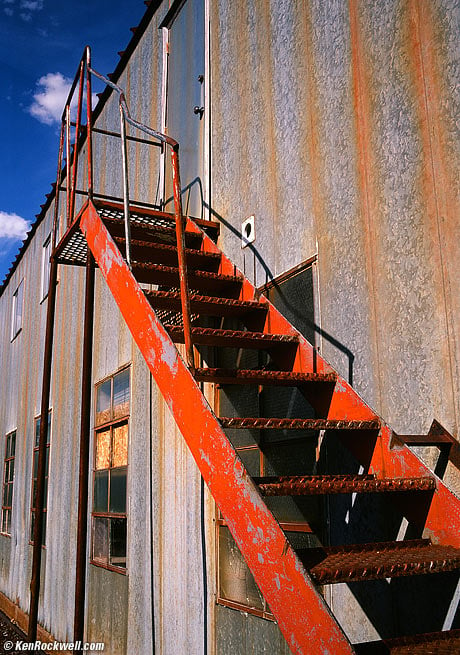
Stairs to Nowhere.
Red, Yellow and Blue. McCloud, California. 5 PM Tuesday, 21 April 2009. enlarge.
Snapped with a Leica M7 and Leica APO-SUMMICRON-M 90mm f/2 ASPH lens with a 55mm Hoya HMC 81A filter.
This isn't a train photo. It's a composition using the three cognitive primaries, red, yellow and blue. These could be garbage cans, painted naked ladies, tennis balls, boats amoebae, or whatever. This photo, like most good photos, is all about its underlying structure, and not at all about what you might think is the obvious subject.
All I worried about when shooting it was the arrangement, weights and balances of the colors and black, and nothing else.
Red, yellow and blue are the cognitive primaries. Geeks refer to the additive primaries, red, green, and blue, and printers refer to the subtractive primaries, cyan, magenta and yellow, while I refer to the artists' cognitive primaries of red, yellow and blue. See also Piet Mondriaan.
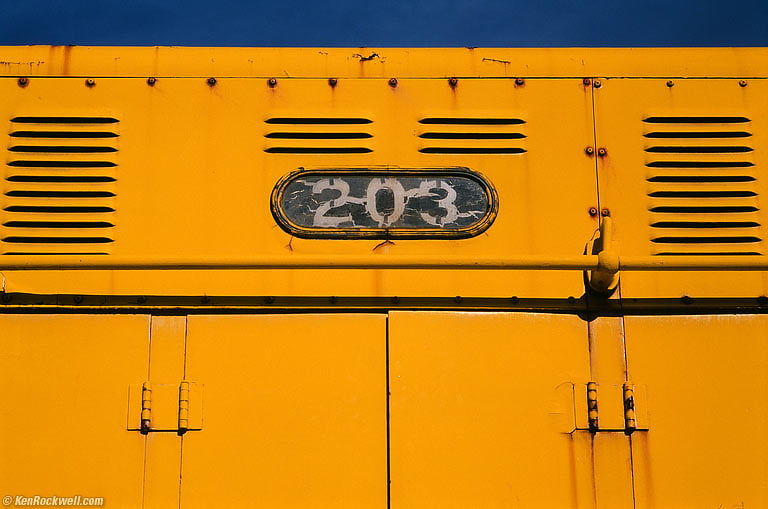
203: Going. McCloud, California. 5 PM Tuesday, 21 April 2009..
Snapped with a Leica M7 and Leica APO-SUMMICRON-M 90mm f/2 ASPH lens with a 55mm Hoya HMC 81A filter.
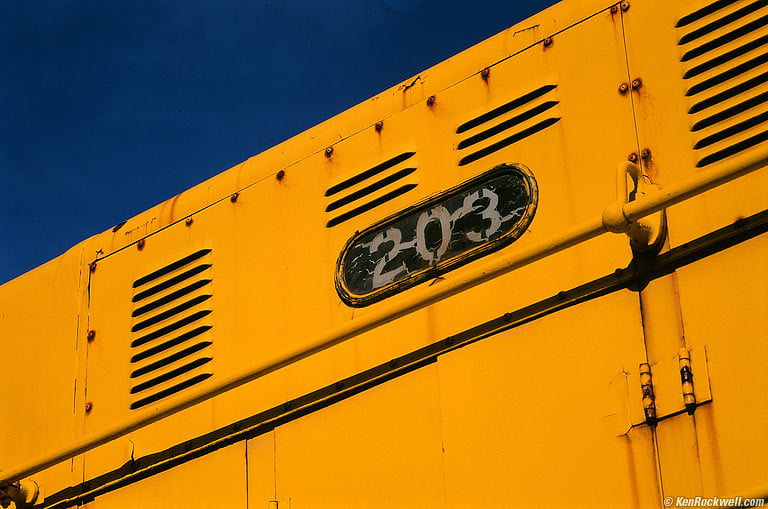
203: Going. McCloud, California. 5 PM Tuesday, 21 April 2009.
Snapped with a Leica M7 and Leica APO-SUMMICRON-M 90mm f/2 ASPH lens with a 55mm Hoya HMC 81A filter.
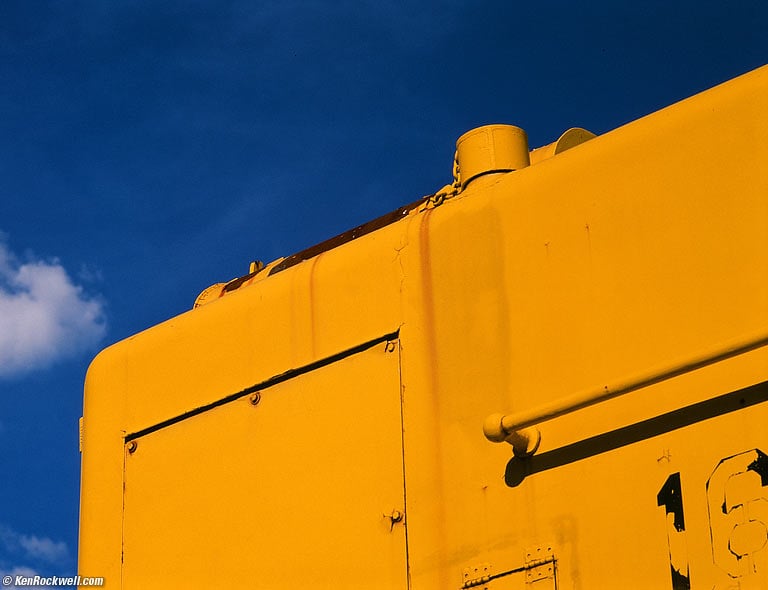
203: Gone. McCloud, California. 5 PM Tuesday, 21 April 2009.
Snapped with a Leica M7 and Leica APO-SUMMICRON-M 90mm f/2 ASPH lens with a 55mm Hoya HMC 81A filter.
When I picked these three images I hadn't realized that they perform a natural progression. We have the 203 straight-on, then the 203 from an angle, and then the angled yellow sans 203.
All three of these photos are about yellow with blue. They aren't train photos. What makes them work are the complementary colors and shapes. The fact that they are part of a train is irrelevant; I'd make the same photo regardless of what the subject was in real life.
Yellow and Violet, Mount Shasta as seen from Weed, California. 7:30 PM Tuesday, 21 April 2009. enlarge.
I forget how I did this; I was having too much fun shooting. It was with a Leica M7 on Velvia, and I think an 85C filter to emphasize the orange. It was with either a 35mm or 21mm lens.
Blue Flame, Weed, California. 7:45 PM Tuesday, 21 April 2009. enlarge.
Snapped with a Leica M7 and Leica 35mm f/1.4 SUMMILUX-M ASPH lens. I forget what filter, probably an 85C and at about f/2 at 1/30.
Blue Breasts, Weed, California. 7:50 PM Tuesday, 21 April 2009. enlarge.
Snapped with a Leica M7 and Leica 35mm f/1.4 SUMMILUX-M ASPH lens. I forget what filter, probably an 85C and at about f/1.4 at whatever Auto chose for me, like all the other shots.
These are mammatoid clouds, named for the breasts they represent in their formal form.
Basilica di Pope Arnold, Sacramento, California. 8 PM Wednesday, 22 April 2009. enlarge.
Snapshot made with a LEICA M7 and LEICA 21mm f2.8 ELMARIT-M ASPH with a 55mm Hoya 85C filter.
Exposure: f/2.8 at 1/6 of a second on Fuji Velvia 50 (ISO 50) film. I hand-held the camera against a railing; there's no time to screw with a tripod when the light is fading.
Why I brought what I brought top
I brought a small 35mm camera with interchangeable 21mm f/2.8, 35mm f/1.4 and 90mm f/2 lenses. I also brought a small 35mm point-and-shoot for fun. I carried it all in a Think Tank Speed Demon waist bag.
I also brought a pocket digital camera (Canon SD880), but I got tired of carrying it the first day and left it back in my luggage.
For you techies, I shot a Leica M7 and also brought along a dinky Olympus 35RC, worth about $15, for fun.
I used Auto exposure for everything (as usual) and shot Fuji Velvia 50.
NCPS developed it and made all these scans at the same time. These shots are pretty much what I got back from NCPS with only a minimum of trimming.
The point-and-shoot was more fun to use most of the time, unless I needed a wider, faster or longer lens. Most of the time, the Olympus was easier, faster and more fun to shoot than the Leica. The results are the same.
I usually use the 21mm most of the time, and the 90mm less often. The 35mm f/1.4 was for low-light; I had the point-and-shoot for daytime shots with a normal lens.
I shot film because this was a long trip. We were staying in different motels each night, so the less I have to carry, the better.
With film, all I brought was a camera and some film.
I didn't have to haul around a big DSLR, bigger lenses, a computer, backup drives, card readers, cables, power supplies, blank DVDs and CDs, camera chargers, power strips, and all the other crap that takes up a separate bag. I just grabbed my camera and went, and each night, I went to sleep. With film, you're done, and never have anything that needs to be backed up, copied or posted. Film is more reliable; it won't erase itself or become unreadable while you're out shooting, and this way I could devote all my attention to the trip and photography, not to computers.
I shoot digital in my studio where I don't have to carry a big DSLR and its life-support systems, but film is much more fun in the field. I'd shoot digital if it were my kids who move too fast for film, but my kids didn't come.
If I wanted to shoot digital on this trip, I would have brought the Nikon 10-24mm for wide, the Nikon 55-200mm VR for tele, the Nikon 35mm f/1.8 for dim light, and the Nikon D40 for its small size. I'd have brought the D40 charger and a couple of 4GB SD cards, but no computer or its life-support hardware. The images from my D40 are great for 20x30" prints, and it weighs so much less than my D3 or clumsy Canon 5D Mark II.
I'm tired of carrying enough to provide ballast for a battleship; I don't need the higher resolution of bigger cameras, and if I did, I'd bring a Nikon D90 which gives the same results as the D3 99% of the time.
Since I shot film, I have more resolution than I'll ever need.
Home Donate New Search Gallery How-To Books Links Workshops About Contact
